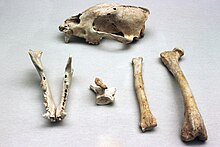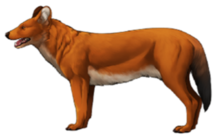
Back Cuon alpinus europaeus Catalan Cuon alpinus europaeus Spanish سگ وحشی اروپایی Persian Cuon alpinus europaeus Italian Cuon alpinus europaeus Russian Cuon alpinus europaeus Ukrainian
| European dhole | |
|---|---|

| |
| Skeletal remains dating back to upper Würm period from Cova del Parpalló, Gandía, Valencia, Spain | |

| |
| Life restoration | |
| Scientific classification | |
| Domain: | Eukaryota |
| Kingdom: | Animalia |
| Phylum: | Chordata |
| Class: | Mammalia |
| Order: | Carnivora |
| Family: | Canidae |
| Genus: | Cuon |
| Species: | |
| Subspecies: | †C. a. europaeus
|
| Trinomial name | |
| †Cuon alpinus europaeus Bourguignat, 1868
| |
The European dhole (Cuon alpinus europaeus) was a paleosubspecies of the dhole, which ranged throughout much of Western and Central Europe during the Middle and Late Pleistocene. Like the modern Asiatic populations, it was a more progressive form than other prehistoric members of the genus Cuon, having transformed its lower molar tooth into a single cusped slicer. It was virtually indistinguishable from its modern counterpart, save for its greater size, which closely approached that of the gray wolf.[1]
- ^ Kurtén, Björn (1968), Pleistocene mammals of Europe, Weidenfeld and Nicolson, pp. 111-114